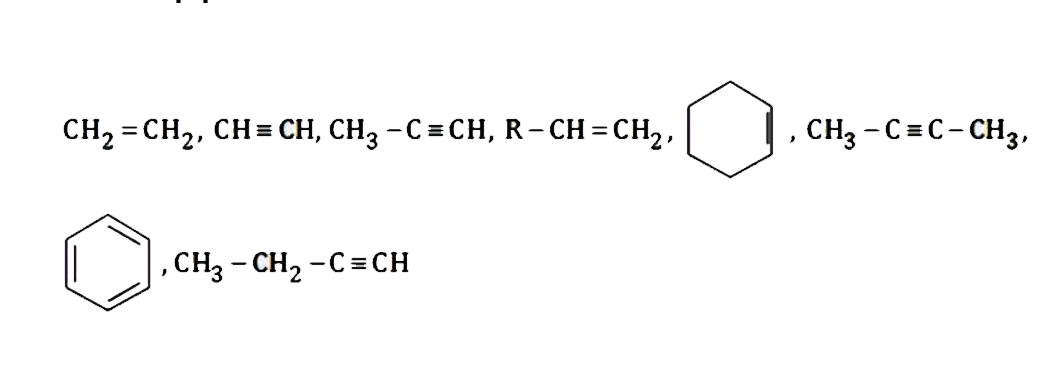Compounds capable of reacting with ammoniacal AgNO3 solution
are
CH3−CH∣CH3−C≡CH
HC≡CH
1−Butyne
all the above
The correct Answer is:D
To determine which compounds are capable of reacting with ammoniacal AgNO₃ solution, we need to analyze the nature of the compounds provided and their reactivity with this reagent, specifically focusing on terminal alkynes.
1. Understanding Ammoniacal AgNO₃:
- Ammoniacal silver nitrate solution, also known as Tollens' reagent, is used to test for terminal alkynes. Terminal alkynes have a triple bond (C≡C) at the end of the carbon chain.
2. Identifying Terminal Alkynes:
- Terminal alkynes have the general formula R-C≡C-H, where R can be any alkyl group. The key feature is that the triple bond is at the end of the carbon chain.
3. Analyzing the Given Compounds:
- If the question provides specific compounds, we need to check if they are terminal alkynes. For example:
- Compound A: R-C≡C-H (Terminal Alkyne)
- Compound B: R-C≡C-R' (Internal Alkyne, does not react)
- Compound C: R-C≡C-H (Terminal Alkyne)
- Compound D: R-C≡C-R' (Internal Alkyne, does not react)
4. Reactivity with Ammoniacal AgNO₃:
- Only terminal alkynes will react with ammoniacal silver nitrate to form a silver alkanide and a white precipitate of silver. The reaction can be represented as:
R−C≡C−H+2Ag(NH3)+2+OH−→R−C≡C−Ag+2NH3+H2O
- The product is a silver alkanide, which is a white precipitate.
5. Conclusion:
- Based on the analysis, if all the given compounds are terminal alkynes, they will react with ammoniacal AgNO₃. Therefore, the answer would be "All of the above" if all provided compounds are terminal alkynes.
Final Answer:
Compounds capable of reacting with ammoniacal AgNO₃ solution are all terminal alkynes.
---
- Ammoniacal silver nitrate solution, also known as Tollens' reagent, is used to test for terminal alkynes. Terminal alkynes have a triple bond (C≡C) at the end of the carbon chain.
- Terminal alkynes have the general formula R-C≡C-H, where R can be any alkyl group. The key feature is that the triple bond is at the end of the carbon chain.
- If the question provides specific compounds, we need to check if they are terminal alkynes. For example:
- Compound A: R-C≡C-H (Terminal Alkyne)
- Compound B: R-C≡C-R' (Internal Alkyne, does not react)
- Compound C: R-C≡C-H (Terminal Alkyne)
- Compound D: R-C≡C-R' (Internal Alkyne, does not react)
- Only terminal alkynes will react with ammoniacal silver nitrate to form a silver alkanide and a white precipitate of silver. The reaction can be represented as:
R−C≡C−H+2Ag(NH3)+2+OH−→R−C≡C−Ag+2NH3+H2O
- The product is a silver alkanide, which is a white precipitate.
- Based on the analysis, if all the given compounds are terminal alkynes, they will react with ammoniacal AgNO₃. Therefore, the answer would be "All of the above" if all provided compounds are terminal alkynes.
Compounds capable of reacting with ammoniacal AgNO₃ solution are all terminal alkynes.
Topper's Solved these Questions
- ALKENE, ALKANE & ALKYNE Book:ALLENChapter:ALKENE, ALKANE & ALKYNE Exercise:EXERCISE-3
Explore 99 Videos
- ALKENE, ALKANE & ALKYNE Book:ALLENChapter:ALKENE, ALKANE & ALKYNE Exercise:EXERCISE-4(A)
Explore 10 Videos
- ALKENE, ALKANE & ALKYNE Book:ALLENChapter:ALKENE, ALKANE & ALKYNE Exercise:EXERCISE-1
Explore 119 Videos
- AIIMS 2019Book:ALLENChapter:AIIMS 2019Exercise:CHEMISTRY
Explore 40 Videos
- ALKYL AND ARYL HALIDEBook:ALLENChapter:ALKYL AND ARYL HALIDEExercise:EXERCISE-05 (B)
Explore 35 Videos
Similar Questions
Which of the following reaction with ammonical AgNO3 solution.
View Solution(KOOC−CH=CH−COOK) undergoes Kolbe's reaction to form a product which reacts with ammoniacal AgNO3 solution to form a precipitate.
The product is a saturated hydrocarbon that forms salt with AgNO3.
View SolutionDeduce the structural fomula of a compound A (C6H10) which shows the following reactions:
i. Adds 2 mol of H2 to form 2-methyl pentate.
ii. Reacts with aqueous H2SO4+HgSO4 solution to give a carbonyl compound.
iii. Does not react with ammoniacal AgNO3 solution.
View SolutionWhat happens when:
Formic acid is reacted with ammoniacal AgNO3 solution
View SolutionA compound (C5H8) reacts with ammoniacal AgNO3 to give a white precipitate and reacts with excess of KMnO4 solution to give (CH3)2CH−COOH. The compound is
View SolutionHow many of these compounds can react with ammoniacal silver nitrate solution to give white ppt.

View SolutionWhich of the following compounds will form the precipitate with aq.AgNO3 solution most readily?
View SolutionA complex compound of chromium chromium contains five NH3 molecules, one nitro group and two chloride ions for one Cr3+ cation. One molecule of this compound produces three ions in aq. Solution, on reacting with excess of AgNO3 solution, two moles of AgCl get precipitated
Q. Magnetic moment off complex compound is:
View SolutionA complex compound of chromium chromium contains five NH3 molecules, one nitro group and two chloride ions for one Cr3+ cation. One molecule of this compound produces three ions in aq. Solution, on reacting with excess of AgNO3 solution, two moles of AgCl get precipitated ltBrgt Q. The formula of the complex compound is:
View SolutionA complex compound of chromium chromium contains five NH3 molecules, one nitro group and two chloride ions for one Cr3+ cation. One molecule of this compound produces three ions in aq. Solution, on reacting with excess of AgNO3 solution, two moles of AgCl get precipitated
Q. The formula of the complex compound is:
View Solution